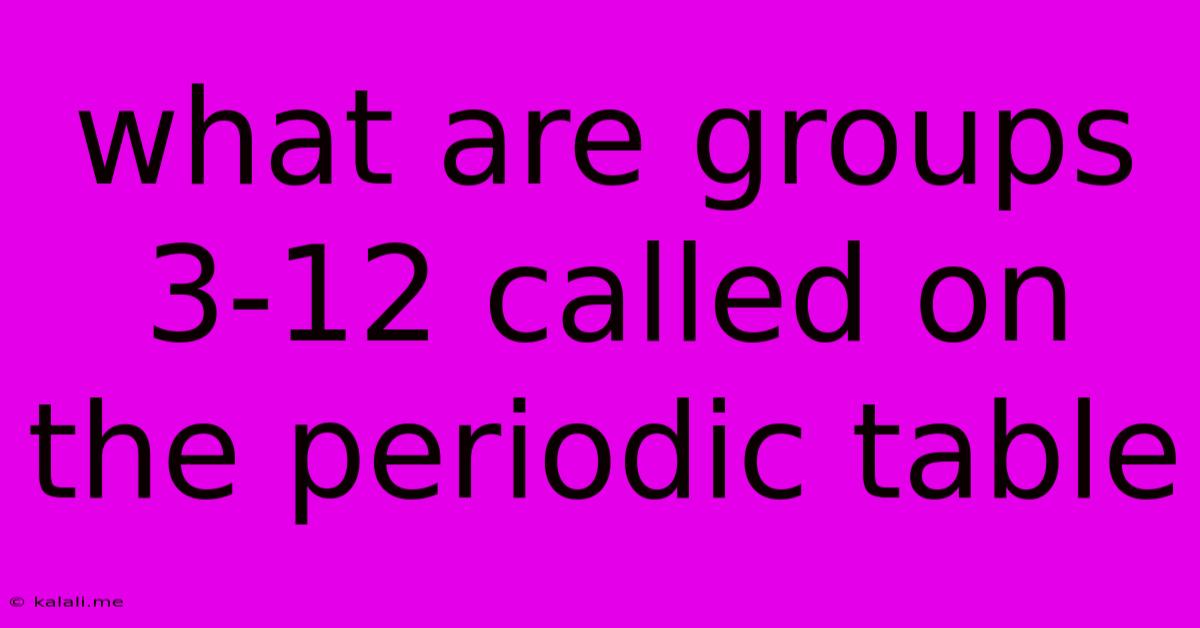What Are Groups 3 12 Called On The Periodic Table
Kalali
Jun 14, 2025 · 3 min read

Table of Contents
What are Groups 3-12 Called on the Periodic Table? Understanding the Transition Metals
The periodic table is a cornerstone of chemistry, organizing elements based on their atomic structure and properties. While the alkali metals (Group 1) and alkaline earth metals (Group 2) are readily identifiable, many wonder: what are groups 3-12 called? These elements, occupying the central block of the table, are collectively known as the transition metals. This article will delve into the characteristics, properties, and significance of this fascinating group of elements.
The transition metals are a unique set of elements distinguished by their partially filled d orbitals. This electronic configuration gives them a range of distinctive properties, setting them apart from other elements on the periodic table. Understanding these properties is key to grasping their importance in various applications.
Defining Characteristics of Transition Metals (Groups 3-12)
Several key features define the transition metals:
-
Variable Oxidation States: Unlike many main group elements, transition metals can exhibit multiple oxidation states. This means a single transition metal atom can exist in different ionic forms, each with a different charge. This versatility leads to a wide array of chemical compounds. For example, iron (Fe) can exist as Fe<sup>2+</sup> (ferrous) or Fe<sup>3+</sup> (ferric).
-
Formation of Colored Compounds: Many transition metal compounds display vibrant colors. This is due to the electronic transitions within their d orbitals, absorbing specific wavelengths of light and reflecting others. This property is exploited in pigments and dyes.
-
Catalytic Activity: Transition metals are renowned for their catalytic abilities. Their ability to readily accept and donate electrons makes them excellent catalysts in various chemical reactions, including industrial processes. This is crucial in areas like petroleum refining and the production of ammonia.
-
Paramagnetism: The presence of unpaired electrons in their d orbitals makes many transition metals paramagnetic, meaning they are attracted to magnetic fields. This property is utilized in various applications, including magnetic recording media.
-
Complex Ion Formation: Transition metals readily form complex ions, which are ions surrounded by ligands (molecules or ions). The formation of these complexes significantly influences their reactivity and properties. This is exploited in coordination chemistry, with numerous applications in medicine and materials science.
-
High Melting and Boiling Points: Generally, transition metals possess high melting and boiling points due to strong metallic bonding arising from their electronic structure. This makes them suitable for high-temperature applications.
Examples of Transition Metals and their Uses
The transition metals encompass a wide range of elements with diverse applications. Here are a few examples:
- Iron (Fe): Crucial for steel production, a cornerstone of construction and infrastructure.
- Copper (Cu): Used extensively in electrical wiring due to its excellent conductivity.
- Titanium (Ti): Known for its high strength-to-weight ratio, utilized in aerospace and biomedical applications.
- Gold (Au) and Platinum (Pt): Valuable precious metals used in jewelry and catalysis.
- Chromium (Cr): Used in stainless steel for its corrosion resistance.
- Nickel (Ni): A component in various alloys and used in batteries.
The Significance of Transition Metals
The transition metals play a vital role in numerous aspects of modern life. Their unique properties make them indispensable in various industries, including:
- Materials Science: Developing advanced alloys with enhanced strength, durability, and corrosion resistance.
- Catalysis: Facilitating chemical reactions crucial for industrial processes.
- Biochemistry: Many transition metals are essential elements in biological systems, playing vital roles in enzyme function.
- Medicine: Used in drug delivery systems and medical imaging techniques.
In conclusion, groups 3-12 on the periodic table are known as the transition metals. Their partially filled d orbitals give rise to their distinctive properties, making them incredibly versatile and essential elements in countless applications. Their unique characteristics are constantly being explored and exploited to advance various fields of science and technology.
Latest Posts
Latest Posts
-
Shortcut Key For Save As In Word
Jun 14, 2025
-
Value Of K In Coulombs Law
Jun 14, 2025
-
Greatest Common Factor Of 48 And 54
Jun 14, 2025
-
How To Write Phd Title After Name
Jun 14, 2025
-
Which Of The Following Is Not Correct About Firewalls
Jun 14, 2025
Related Post
Thank you for visiting our website which covers about What Are Groups 3 12 Called On The Periodic Table . We hope the information provided has been useful to you. Feel free to contact us if you have any questions or need further assistance. See you next time and don't miss to bookmark.